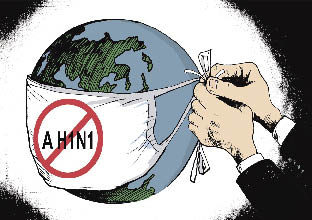| China Goes All Out to Ward off H1N1 Flu
By staff reporter ETHEL LU

AFTER its debut in late March, A/H1N1 flu soon spread from Mexico and the U.S. to more than 30 countries and regions worldwide, including China's mainland and Hong Kong, causing global alarm and prompting a flurry of precautions. By April 27 the World Health Organization had raised its pandemic alert level from Phase 3 to 4, and only two days later, to the second place register on the scale.
On April 25, in order to ward off the infectious disease, an urgent notice was addressed to people visiting China from flu-hit areas, and people already in China who had recently transited infected areas. The General Administration of Quality Supervision, Inspection and Quarantine required those just arriving from Mexico or other locations of recorded outbreaks to inform custom officials of any flu-like symptoms. Returned travelers, if they had transited these locations within the previous two weeks, were urged to contact local quarantine authorities the moment they experienced flu-like symptoms. At 8:00 pm on May 3, with the pandemic still escalating, China took a more stringent protective measure, reinstating the compulsory health declaration card for all people entering the country.
Helping the public protect themselves from infection was a simultaneous undertaking. On April 26 the Ministry of Health opened the column Questions and Answers on Preventing H1N1 Flu on its official website. Soon after, the ministry circulated national guidelines for diagnosing and combating the disease, which provide not only advice on testing and treatment but minute details of its etiology (origins) and epidemiology (frequency and spread).
As this public and professional education on swine flu was rolling out, the Ministries of Health and Education co-sponsored an equivalent campaign at schools at all levels, alleviating panic among teachers and students and restoring confidence in the power of preventive tactics.
After the SARS outbreak in 2003 China established an exemplary monitoring system for epidemics and sudden catastrophic threats to public health. All disease-control centers in China are connected to an on-line epidemic reporting system, assures Mao Qun'an, chief of the Health Education Center under the Ministry of Health. Information on a case in any part of the nation can be delivered to relevant authorities in the capital within seconds.
At the regular meeting of the State Council, Chinese Premier Wen Jiabao reiterated the importance of cooperation with other nations and international organizations, and vowed financial, material and technological assistance to countries and regions in need. In late April the Chinese government committed to relief for Mexico of US $5 million, which includes US $1 million in cash and US $4 million in medical supplies and equipment. By May 5 two of these shipments had already been delivered to Mexico, still the worst affected region in the world.
Treatment of potential H1N1 flu patients will occur in hospitals across the nation specifically designated to receive these emergency cases. A reserve of flu antidote has been stockpiled. The central government has set aside RMB 5 billion for efforts to both prevent and fight the disease, and local governments are expected to follow suit.
The measures were enacted none too soon. On May 1 Hong Kong confirmed its first case of H1N1, a Mexican male who flew from Mexico to the special administrative region via Shanghai. On May 9 a Chinese man surnamed Bao, returning to China from his studies in the U.S, began to show the tell-tale symptoms during a flight from Beijing to Chengdu: sore throat, cough, and a stuffy, running nose. Mr. Bao's body temperature had been normal on the first leg of his trip from St. Louis via St. Paul and Tokyo. After landing in Chengdu, he was immediately rushed to Sichuan People's Hospital, and later tested positive for the H1N1 virus. On May 12 yet another suspected case was reported in Shandong Province, involving a 19-year-old Chinese student from Canada.
As news of a possible outbreak on Chinese soil flashed across the country, passengers on the same flights as the Mexican patient and Mr. Bao were tracked down and isolated for a week of observation.
By May 3 every passenger on the Mexico-China flight had been located, and those still present in China entered quarantine in the regions where they lived or stayed. Among them were two staff members of China Today, who returned from the company's Mexican office on the Mexico-Beijing flight. The same work was carried out after the cases of Mr. Bao and the student were exposed.
On May 11 President Hu Jintao called for enhanced vigilance and strict enforcement of preventive measures against the spread of A/H1N1 flu.
Following his directive, public transport administrations demanded operators in the sector to step up preventive efforts. Post offices did their bit as well, by setting apart particular sections of their premises to store and sterilize mail and packages from countries and regions with confirmed flu cases.
Dr. Hans Troedsson, WHO's chief representative in China, expressed satisfaction with China's response to A/H1N1 flu, saying the country is demonstrating how well prepared it is, and in so many ways. He believes China has established and tested an effective surveillance system for epidemics, having learned a valuable lesson from the SARS and avian flu experiences of recent years.
| 
